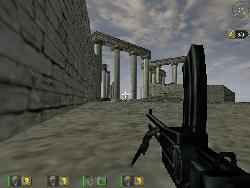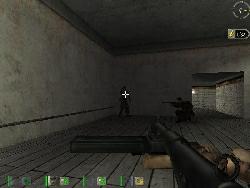

Page 2
If you aren't familiar with H&D, the interface is quite simple to understand. First you will select a campaign, which actually represents a complete SAS operation. Each campaign is composed of several missions/phases, with their number varying from case to case. The phases might include the insertion or extraction from the Area of Operation, but this is not a rule of thumb. At the start of the campaign, you will get to choose eight men that will form your team, and the equipment the whole team will take. You will not get replacements until the end of the campaign, but supplies can be picked up from dead enemies or found in stockpiles.
Fig. 3. The canyon in all it's gloryBefore each mission, you are treated with a 3D briefing showing you its objective and intelligence information. Then you pick four of your men that will be your group of action for it. You also get to equip them individually, using only the supplies that were inserted with you at the beginning of the campaign. Since at that time you didn't know what sort of missions you can expect, it is possible to find yourself in trouble by lacking an essential piece of hardware. However, a careful SAS operative will pack his bag to the limit with all sorts of explosives, just in case, and will rarely need more. If in trouble, you will most likely discover that a grenade can very well fill the role of a bazooka or a timed TNT charge, blowing up even Panther tanks.
Fig. 4. The AI seems to use a higher resolutionAfter arming your men, you're off to the mission. Fight for Freedom boasts only nine of these, but they are on par with the largest ones found in the first Hidden & Dangerous game, and will take you some time to complete. The first campaign, containing two missions, takes place in Poland, where your men will rescue a captured allied spy and steal an experimental jet bomber. The second campaign is three missions long and puts your troops in support of american paratroopers during the Battle of the Bulge. Finally, the last four missions are set in Greece, after the war, as the uprising of communist guerrillas demands an active British presence in the region.
Fig. 5. The crosshair makes long range shots difficultJust like in the first game, the designers seem to have tried to give you a fresh perspective of the war in every mission. While some of their work bears a vague resemblance to scenarios played before, most of the time they succeed in doing this. This is most true in the case of the Greece campaign, which I think is the highlight of this mission pack.
In one case you will have to rescue some villagers kept hostages by the commies, and just like in Rainbow Six, the premature detection of your team will lead to their death. Also, another level is so huge, I could not believe my eyes. I was supposed to go through a canyon and clear all enemy resistance, but after a couple of hours (including saving and loading several times) I had only advanced a fourth of its total length. The scenery is simply incredible, with bridges crossing the sky above you, and trails going up and down on both sides of the road.
Fig. 6. Two on one in the final missionJust as before, the game looks absolutely fantastic, and I think the developers used better textures this time around. Frankly, I think it's the best 3D shooter engine released so far, as it offers both huge outdoor spaces (although not the size of those in Delta Force) and indoor action, without giving up the advantages of 3D acceleration.




